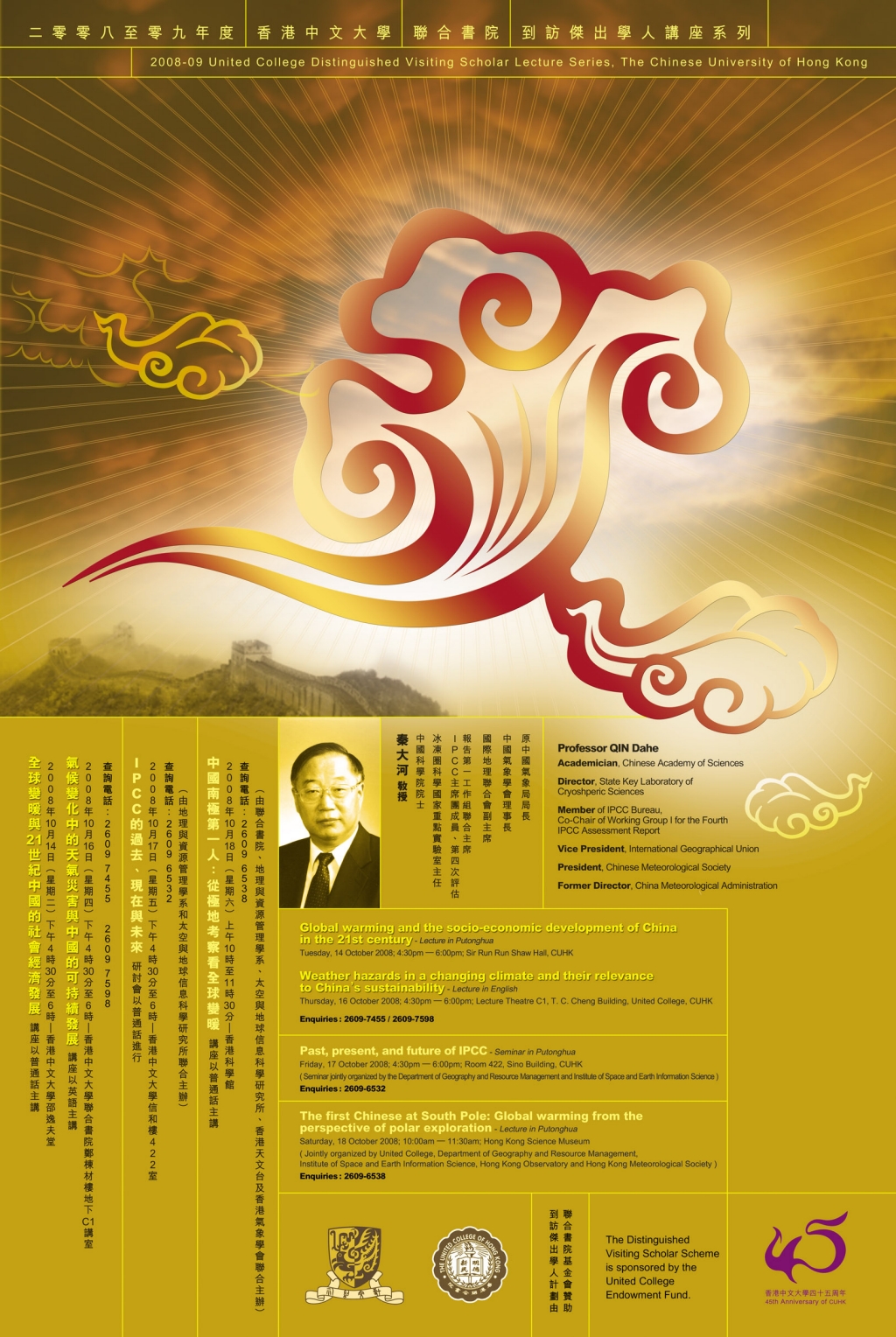 |
秦大河院士簡介
秦大河院士是國際著名的氣候和全球變化研究專家。他現任冰凍圈科學國家重點實驗室主任、政府間氣候變化專門委員會(IPCC)主席團成員、第4次評估報告第一工作組聯合主席、國際地理聯合會副主席、中國氣象學會理事長、第11屆全國政協人口資源環境委員會副主任。秦院士原任中國氣象局局長和國家氣候委員會主任,為國家的氣象氣候事業作出重大貢獻。今年6月,秦院士被授予第53屆國際氣象組織(WMO)獎,是獲得WMO最高榮譽的第2位中國人。去年12月,他作為IPCC代表團主要成員,代表中國科學家出席了諾貝爾和平獎頒獎儀式。
秦大河院士長期從事冰凍圈與全球變化研究,多次參加、主持南、北極、青藏高原和中國西部地區的科學考察和研究,取得了許多創新性成果。他系統研究了南極冰蓋雪層的“變質”過程,從定量分析入手,總結出了雪到冰川冰演化過程的地域分異規律;他對南極冰蓋表層雪內的物理、化學過程與氣候環境記錄之間關係進行了深入的研究,有關降水中穩定同位素比率的分佈規律與溫度的關係、水汽和多種雜質來源與輸送路徑的研究結果,是迄今為止國際上對南極冰雪表層最廣泛、最全面的研究成果,得到了國內外同行的認可,使中國南極冰川學研究躍登國際先進行列;他率先在中國西部開展雪冰現代過程和雪冰生物地球化學迴圈實驗觀測研究,論證了我國山地冰芯中氣候環境指標的適用性;他對珠穆朗瑪峰地區冰川變化、環境變遷和冰芯綜合研究,揭示了地球最高海拔地區近/現代氣候環境的變化特徵。秦院士主持《中國氣候與環境演變》和《中國西部環境演變評估》研究,產生廣泛影響,促進了我國與國際氣候變化研究工作的不斷進步,為推動全球變化研究做出了突出貢獻。
Brief Introduction of
Professor Qin Dahe
Professor Qin is an
internationally renowned climatologist and expert on global change. He is
currently the Director of State Key Laboratory of Cryoshperic Sciences, Member of IPCC Bureau, Co-Chair of Working
Group I for the Fourth IPCC Assessment Report, Vice President of International Geographical Union, President of Chinese Meteorological Society, and Vice Chairman of
Commission on Population, Resource and Environment of the 11th
National Political Consultative . In June this year he received the 53rd
World Meteorological Organization (WMO) Prize and became the second Chinese
recipient of this highest award of WMO. Last December as a key member of IPCC
Bureau, he represented Chinese scientists to attend the award ceremony of Noble
Prize for Peace of 2007.
Over the past three decades Professor Qin has been
actively and productively engaged in cryospheric and global change studies. He
has participated and taken a leading role in numerous scientific exploration
and research projects in the South Pole, North Pole, Qinghai-Tibetan Plateau
and the western region of China. He has systematically studied the “decay”
process of ice cap in the South Pole and used a quantitative approach to
characterizing the regional patterns of the evolution of snow to glacier ice.
His research has investigated the relationship between the physical/chemical
processes in the surface snow layer of South Pole ice cap and the environmental
records of climate. The research findings in several areas, such as the
relationship between the distribution of stable isotopes in precipitation and
air temperature, sources and pathways of water vapor and multiple impurities,
are still the most comprehensive and in-depth results of research on South Pole
ice cap. Professor Qin has carried out pioneering work on the monitoring and
experiment of modern processes and biogeochemical cycling in snow and ice
cover, demonstrating the applicability and validity of climatic signals derived
from mountainous ice cores. His research on glacial evolution, modern
environmental changes and ice cores in the Mt. Qomolangma (Everest) area has
discovered the characteristics of modern climate change in the highest
elevations of the earth. Under the leadership of Professor Qin, studies on
“Climate of China and Environmental Change” and “Assessment of Environmental
Changes in China’s West” have produced numerous influential results and made
important contributions to global change research.
講座摘要
全球變暖與21世紀中國社會經濟發展
全球氣候變暖已成為人類的共識。政府間氣候變化專門委員會(IPCC)2007年發表的第四次評估報告(AR4)以更準確的資料證明,人類活動是1750年來地球氣候系統的變暖的因素之一,而最近五十年的升溫,無容置疑是人類活動的結果(置信度在90%以上)。根據不同排放情景,預估2100年全球地表平均升溫1.8 – 6.4℃,海平面上升0.18 – 0.59m,冰川、積雪、海冰和凍土都有大幅度退縮,但不包括南極冰蓋快速冰流的變化。極端天氣氣候事件發生的頻率很可能增加,如更熱的天氣、強降水、乾旱等,未來熱帶氣旋(包括颱風和颶風)可能更強,並伴有更強的風速和更大的降水量;高緯地區降水很可能增加,而多數副熱帶大陸地區降水量可能減少,等等。因此,應對氣候變化,適應和減緩氣候變化給全人類帶來的負面影響,採取共同行動,成為各國的政府和全人類的共識。
相對而言,全球變暖及其影響在中國的表現更為顯著。中國近百年平均氣溫升高了1.1℃,最近50年北方地區增溫最為明顯,升溫最高已達4℃。最新預估結果顯示,到2020年中國年平均氣溫可能比20世紀後20年升高0.5至0.7℃,到2030年可能升高0.6至1.0℃,到2050年可能升高1.2至2.0℃,到本世紀末可能升高2.2至4.2℃;北方增暖大於南方,冬春季增暖大於夏秋季;如果21世紀末全國平均氣溫升高3℃左右,這意味著21世紀的增暖將可能超過近千年內任何時期。
中國降水分佈格局發生了明顯變化。近50年來,西部地區降水約增加15%至50%;東部地區頻繁出現“南澇北旱”,華南地區降水約增加5%至10%,而華北和東北大部分地區約減少10%至30%。預測表明,到2020年,中國平均年降水量可能比20世紀後20年略有增加,到2050年可能增加2%至5%,到本世紀末可能增加6%至14%。北方的降水總量增加幅度大於南方,南方大雨日數增加。
中國極端氣候事件的發生頻率和強度變化明顯,主要表現在夏季高溫熱浪增多、區域性乾旱加劇以及強降水增多。21世紀中國極端高溫事件可能更為頻繁,部分地區夏季炎熱日數可能增多,暖冬與熱夏的次數可能增加;降水增加主要表現為強降水事件增多;颱風和強對流天氣可能更強;冬季寒潮將可能繼續減少。極端事件的頻率和強度無疑加劇了自然災害造成的損失,對水資源、農業、工業 、交通運輸和社會公共事業等帶來不利,加上巨大的人口數量,應對不力,必將影響21世紀中國經濟社會發展。
中國是世界上人口最多的國家,是一個中低收入的發展中國家,是遭受氣候變化不利影響較為嚴重的國家。中國人口佔世界總人口21%;中國人均二氧化碳排放還比較低,不到發達國家平均水準的三分之一;中國仍有2,000多萬農村貧困人口和2,200多萬城市最低生活保障線以下人口,城鄉和區域經濟社會發展還不平衡。為了改善和提高13億中國人民的生活水準和生活品質,應該把經濟增長、社會發展、環境保護統籌協調起來,建立適應可持續發展要求的生產方式和消費方式。為應對氣候變化而停滯發展,或者無視氣候變化片面追求經濟增長都是不可取、不可行的。讓貧困人口得到現代能源的服務,進而享受發展的機會,是一種道義責任和社會責任。氣候變化從根本上說是發展問題,因此應對氣候變化的努力應該促進而不是阻礙發展中國家發展經濟、消除貧困。
氣候變化又是一個全球性問題,需要世界各國攜手合作,共同應對。發達國家應該正視自己的歷史責任和當前人均排放水準仍然居高的現實,嚴格履行《京都議定書》確定的減排目標,在2012年後繼續率先減排。包括中國在內的發展中國家應該根據自身能力積極採取有效措施,為應對氣候變化做出力所能及的貢獻。國際社會應該加大對發展中國家的支持,發達國家應該履行對發展中國家的技術轉讓和資金支援承諾,切實幫助發展中國家提高減緩和適應氣候變化能力。
中國政府充分認識到應對氣候變化的重要性、緊迫性,本著對本國人民負責、對全人類負責、對子孫後代負責的精神,主動採取了一系列減緩溫室氣體排放的政策措施,取得了重要進展。中國已確立了堅持走低消耗、低排放、高效益、高產出的新型工業化道路的發展目標。相信,堅持依靠科技、和諧發展,一個清潔發展、可持續發展的中國必然可以成為現實。
Weather hazards in a
changing climate and their relevance to China’s sustainability
Average air temperature of the globe and China has increased by 0.74 oC and 1.1 oC over the past 100 years and the warming is most likely due to human
perturbation. Compared with 1980-1999, average air temperature of the globe,
China and Hong Kong will probably increase by 1.1-6.4 oC, 2.2-4.2 oC and 1.7-5.6 oC, respectively, by the end of the 21st
century.
Extreme and
hazardous weather phenomena such as heat wave, heavy rain storm and flooding,
and wind storm have occurred frequently since the 1950s. Especially since the
1970s, droughts in the tropical and sub-tropical regions have become even more
frequent, lasting and severe, affecting many places of ever expanding areas.
With the intensification of typhoons and hurricanes, the percentage of strong
typhoons has increased from less than 20% in the early 1970s to over 31% in
recent years. Given the overall warming trend of global climate, the frequency
and intensity of hazardous weather have changed significantly as demonstrated
by numerous evidences. Heat wave events in summer have become more and more
recurring, especially since 1998 the number of hot days with air temperature of
over 35 oC has continuously and
significantly exceeded the norm. Regional droughts have intensified, especially
in northern China where droughts occurred in 8 years over the past two decades.
Heavy rain storms have become more frequent and the recent 20 years have been
another period of severe flood hazards since the 1950s. Although the typhoon
frequency has not changed significantly, its intensity has demonstrated a
substantial increase. As predicted by simulation models, hazardous weather will
probably become more frequent in China. It is likely that we will have more hot
days in summer and more warm days in winter. Precipitation will increase as
evidenced mainly by the increase of heavy rainfall events. Typhoons and
convective weather of high intensity will probably become stronger.
The remarkable changes of climate and
hazardous weather will bring tremendous challenges to China’s sustainability in
many areas such as reduced stability of agricultural production, shortage of
water resources, recession of glaciers, increased risk to engineering safety,
threat of sea level rise in coastal developed regions and the resulting damages
to the urban agglomerates in Guangdong.
Even if the percent of GDP loss will not change, the absolute amount of
economic loss caused by weather hazards will escalate as Chinese economy
continues to grow rapidly. Therefore, we must make every effort to improve our
capability of climate change prediction and to take adaptive measures for
minimizing the negative impacts of climate change in order to ensure the
sustainability of socio-economic development of China. An effective approach is
to control and reduce the emission of pollutants and greenhouse gases at their
sources. To face the challenges of climate change and hazardous weather,
research and innovation through international cooperation will play a very
important role in enhancing China’s sustainability through maintaining a good
balance among economic growth, societal development and environmental
protection.
氣候變化中的天氣災害與中國的可持續發展
近百年全球和中國地表平均溫度分別上升了0.74℃和1.1℃,近50年的氣候變暖很可能是人類活動引起的。與1980~1999年相比,21世紀末全球、中國和香港地表平均溫度可能會分別升高1.1∼6.4℃、2.2~4.2℃和1.7~5.6℃。
20世紀50年代以來,全球許多地區熱浪頻繁發生,強降水事件和局部洪澇頻率增大,風暴強度加大。尤其是70年代以來,熱帶和副熱帶地區的乾旱更頻繁、更持久、更嚴重,影響範圍不斷擴大;颱風和颶風強度增大,強颱風的頻率增大,由70年代初的不到20%,增加到21世紀初的35%以上。在全球氣候變暖的大背景下,中國天氣災害的發生頻率和強度變化明顯。夏季高溫熱浪增多,特別是1998年以後,35℃以上的高溫日數連續顯著高於常年平均。區域性乾旱加劇,特別是華北地區最近20多年中有8年發生乾旱。強降水增多,最近20年是繼20世紀50年代之後長江和淮河流域洪水災害高發期。登陸中國的颱風頻數沒有明顯的變化,但強度有較為明顯的增加趨勢。霾天氣增多。模式預估21世紀中國天氣災害發生的可能更為頻繁,部分地區夏季炎熱日數可能增多,暖冬與熱夏的次數可能增加;降水增加主要表現為強降水事件增多;颱風和強對流天氣可能更強。
氣候及天氣災害的顯著變化對中國可持續發展帶來了嚴峻的現實威脅:農業生產不穩定性增加;水資源問題日益嚴峻;冰川顯著退縮;重大工程安全運行的風險加大;沿海經濟發達地區受到海平面上升威脅,廣東地區城市群將面臨巨大衝擊。鑒於中國經濟發展速度快、體量大,即便災害造成損失佔GDP的比例不變,但經濟絕對損失量仍將大大增加。為此,必須提高預測預估的科學水準、積極應對氣候變化對經濟社會可持續發展的影響,採取適應性措施,減輕氣候變化與天氣災害造成的負面影響,充分利用氣候變化對我國部分地區或部門發展可能帶來的機遇,保障社會經濟可持續發展。要採取減緩措施,控制和減少污染物和溫室氣體的排放,在源頭上減緩氣候變化的速率和程度。要大力發揮科技進步和創新的作用,健全應對氣候變化和天氣災害的體制機制。廣泛開展國際交流合作,以處理好經濟增長、社會發展、保護環境三者關係為出發點,增強可持續發展能力。